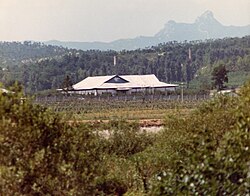This article needs additional citations for verification. (November 2022) |
Panmunjom
Panmunjeom | |
|---|---|
| Korean transcription(s) | |
| • Hangeul | 판문점 |
| • Hancha | 板門店 |
| • McCune-Reischauer | P'anmunjŏm |
| • Revised Romanization | Panmunjeom |
 The original truce building in 1976, after it became the DPRK Peace Museum | |
| Coordinates: 37°57′36″N 126°39′54″E / 37.96000°N 126.66500°E | |
| Country before the Korean War | |
| Modern countries | |
| Kaesong | |
| Panmun-guyok | |
| Gyeonggi | |
| Paju | |
Panmunjom (also spelled Panmunjeom) was a village just north of the de facto border between North Korea and South Korea, where the 1953 Korean Armistice Agreement that ended the Korean War was signed. It was located in what is now Paju, Gyeonggi Province, South Korea and Panmun-guyok, Kaesong, North Korea. The building where the armistice was signed still stands.
Its name is often used as a metonym for the nearby Joint Security Area (JSA), where discussions between North Korea and South Korea still take place in blue buildings that straddle the Military Demarcation Line. As such, it is considered one of the last vestiges of the Cold War.
